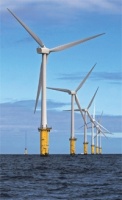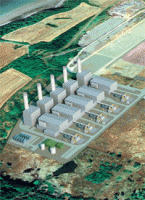It has long been predicted that the UK faces an acute energy gap in the near future. The recent cold weather threw those claims into focus, with the National Grid sourcing additional gas supplies from Russia to meet demand and warning large industrial customers to ease off on fuel use.
The government has backed new nuclear-power stations, but gaining approval for any new generating plant, from coal to nuclear and renewables, has proved difficult under the UK’s planning system.
Is it then a gloomy and frustrating time to be in the power-generation industry? Not at all, according to Kevin McCullough, chief technology officer of RWE Npower. ‘I always try to emphasise how exciting this sector is,’ he said. ‘This decade will see the biggest rebirth of energy infrastructure since the Second World War.’

Over the next few years, a large chunk of the UK’s 80GW of installed capacity will need replacing for one reason or another, he explained. The last Magnox nuclear reactor, at Wylfa, will stop generating within 12 to 18 months. British Energy’s advanced gas-cooled reactors will reach the end of their lives between around 2013 to 2017. The EU large-combustion-plant directive will lead to the phasing out of older, less efficient coal-fired plants. ‘Of the 80GW, 35-40 per cent will be dead and gone by the end of the decade,’ McCullough said. ‘We have to replace those assets against an ever-changing political landscape of what’s acceptable.’
The crunch point is fast approaching. ‘The crucial time for the energy gap will be 2013 and 2016, when large coal plants are opted out under the directive and the AGRs will close.’
So how will the UK cope? The medium-term solution will be more gas-fired generation. Npower is building two state-of-the-art gas-turbine power stations at Staythorpe and Pembroke to replace coal-fired capacity at Tilbury and Didcot.
New nuclear capacity will only be starting to come on to the grid by the end of the decade, he predicts, so the majority of UK generation will be from gas. ‘That raises its own political concerns,’ he added. ‘We’re relying on gas from ever more fragile parts of the world, so being heavier on gas can only be a short-term fix.’
Restoring diversity will require a rapid increase in renewables and nuclear.
Npower’s generating mix currently includes 42 per cent each from coal and gas, eight per cent nuclear and five per cent renewable.

McCullough chairs the Horizon Nuclear Power joint venture, formed last year with E.on, which aims to develop at least 6MW of nuclear capacity — costing £15bn — in the UK by 2025. It has taken options on sites at Wylfa in Anglesey and Oldbury-on-Severn in Gloucestershire. It is supporting the Westinghouse AP1000 and Areva EPR reactors in the current generic-design appraisal being conducted by the Nuclear Installations Inspectorate. The joint venture expects to decide on its preferred technology by this summer so that it can go on to the next stage — to seek the Horizon board’s approval for investment to procure long-lead items such as reactor vessels.
Sister company RWE Innogy, responsible for RWE’s renewables portfolio, is also investing heavily in hydro, biomass, and onshore and offshore wind power.
McCullough, who was chief operating officer of this division until October 2009, is convinced that renewables, and wind power in particular, are finally poised to become a major contributor to energy supplies. Detractors of wind power have, he said, been ‘mischievous’ in pushing the argument that wind power is intermittent and unreliable.
“This decade will see the biggest rebirth of energy infrastructure since World War II”
‘A responsibly sited wind turbine will generate electricity 85-90 per cent of the time — not necessarily at full power,’ he explained. ‘A well-sited onshore turbine is generating at its full output for 30 per cent of the time. For offshore it’s 40 per cent. When you look at the fantastic wind resources of the UK, with a geographical dispersal of capacity, the net effect is a very substantial input from wind.’
Kevin Mccullough
Chief Technology Officer RWE Npower
Education
- BEng (Hons) in Mechanical and Electrical Engineering through part-time study in the 1990s
Career
- 1984 Central Electricity Generating Board (CEGB) and held a number of operations and engineering positions at Ferrybridge, Drax and Staythorpe coal-fired power stations and Killingholme gas-fired power station
- 1996 Appointed production manager at Little Barford gas-fired power station
- I998 Became station manager at Midlothian CCGT power station in Dallas, Texas
- 2000 Took up the position of executive vice-president at Innogy America LLC in Chicago.
- 2003 Managing director of Npower renewables
- 2007 Joined RWE Innogy in 2007 as chief operating officer, with pan-European responsibility for on- and offshore wind-power activities
- 2009 Appointed chief technical officer
RWE Innogy is making a big push in the UK, behind offshore wind in particular. The company won licences to develop offshore wind in the Crown Estate’s tender process last year for the 1.5GW Atlantic Array in the Bristol Channel Zone and as part of the Forewind consortium (with Scottish & Southern Energy and Norwegian energy companies Statoil and Statkraft) for the 9GW Dogger Bank Zone.
Off the North Wales coast, RWE Innogy already operates the UK’s first large-scale offshore wind farm, North Hoyle (60MW), and the 90MW farm at Rhyl Flats, which is currently being commissioned. It has gone out to tender for the construction of nearby Gwynt y Môr offshore wind farm (576MW) and also owns a 50 per cent share of the 500MW Greater Gabbard installation off the east coast of England, due for completion in 2011.
The company is also backing as yet unproven wave and tidal power technologies. ‘We’re putting cold, hard cash into companies we believe have a chance of being disruptive,’ McCullough said. This includes the Siadar Wave Energy Project (SWEP) on the Isle of Lewis in the Outer Hebrides, a joint project with Voith Hydro Wavegen, using Wavegen’s oscillating-water-column principle in an ‘active breakwater’ to harness up to 4MW of electricity from the Atlantic waves. Construction contractors have been appointed and the project is expected to be generating electricity by 2012.
It is also planning to develop, in partnership with Marine Current Turbines as Seagen Wales, a 10.5MW commercial tidal-power scheme in Skerries, Anglesey, following construction of a smaller-scale (1.2MW) demonstration plant in Strangford Lough in Northern Ireland in 2008. Subject to successful planning consent and financing, the Anglesey tidal farm could be commissioned as early as 2011 or 2012.

Planning consent is, of course, the UK’s bugbear. Will recent reforms such as the creation of the Infrastructure Planning Commission help? ‘When I look at how arduous it was to put some wind turbines in a field — taking anywhere from three to seven years — any improvement would be welcome,’ McCullough said. There has been progress, though. ‘I take my hat off to the government for the establishment of the Department for Energy and Climate Change. That was a massive step forward. We have a very real focus on the issues pertaining to energy under one roof. Previously we’ve had all sorts of splits — it was a disaster.’
He added: ‘I’ve sat on the government’s renewables advisory board and I have to say they’ve listened on issues such as grid access and issues associated with planning. It was a large stimulant to create the IPC.’ He is guarded though about whether the IPC will be transformative. ‘I hope it will, but I’m a realist,’ he said. Many of the schemes we’re talking about are not just 10 turbines in a field.’ The Gwynt y Môr offshore wind farm will cover an area of 79km2 — ‘that’s not something that can be glibly approved.’
McCullough added: ‘What my company needs is responsible planning and decision making. Our job as a utility is to choose and apply for sites that we think are genuinely sensible, genuinely needed and genuinely considerate of the amenity in which they will sit. We all rely on the power we generate and we all have to act responsibly.’
Q&A Generation gap
Engineering UK says the engineering industry needs nearly 600,000 new engineers by 2017 and there is concern that the UK has lost much of its nuclear expertise in the last two decades. How serious is this?
It’s across the board — it’s wrong to think it’s just a nuclear shortage. We have an ageing workforce and for the last 15-20 years we have not been able to reap the engineering and science graduates from our education system because engineering and science has not been promoted
Is Npower trying to address this issue?
We have a number of programmes that start very early in school life, starting with Climate Cops, which introduces the challenge of climate to children at junior school. At secondary school we have a series of things we do, from Women in Science and Engineering initiatives to the Enthuse programme.
Who is Enthuse aimed at?
It’s for 14-15 year olds who are about to choose their GCSE subjects. You go along for the whole day and set up a host of experiments. We get them to think about technology — Ipods, plasma TVs — and look at their energy use and where they’re manufactured. By the end of the day you see a complete transformation.
And after secondary school?
We have affiliation with a number of universities, we run graduate programmes. We’re trying to get involved all the way through the educational process, not just at the end.
Is it making a difference?
The quality and volume of applications we’re getting is increasing tremendously. We’re taking on more graduates every year. We need to keep making this investment in replacing people.
What would you say to people considering their career choice?
We’re on the precipice of a very major change in the energy sector. We would like a lot more fresh blood and help. There are a lot of clever people in our business. I need every single one of them to come to work enthused, with their mind switched on and open — and they will have a ball.




Glasgow trial explores AR cues for autonomous road safety
They've ploughed into a few vulnerable road users in the past. Making that less likely will make it spectacularly easy to stop the traffic for...